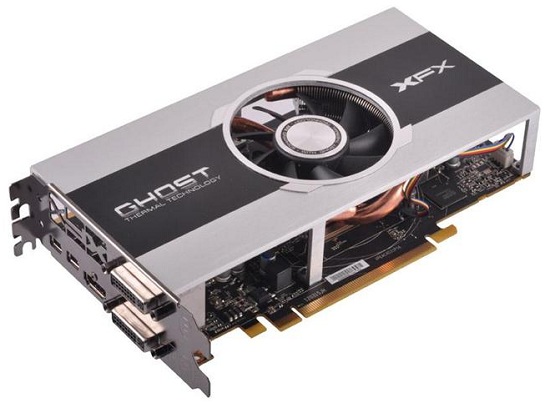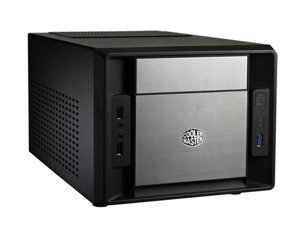Holiday 2012 Small Form Factor Buyer's Guide
by Zach Throckmorton on December 5, 2012 1:55 AM ESTIntel SFF gaming system
The de facto king of the gaming CPUs remains the Intel Core i5-3570K, a quad-core SKU with a base frequency of 3.4GHz that can turbo to 3.8GHz, and features an unlocked multiplier for easy overclocking. Though the K-series chip is easy to overclock and doesn't produce much additional heat (vs. stock) when modestly overclocked, you'll want to exercise caution overclocking in a mini-ITX box.
 To facilitate conservative overclocks of the i5-3570K, ASRock's Z77E-ITX motherboard gets our recommendation for a relatively inexpensive Z77 ITX board that nevertheless performs well. It's also laid out in a manner that facilitates easier cable management than many other Z77 boards when placed in our recommended case, the BitFenix Prodigy. The Prodigy is an interesting case, from its appearance to its internal layout. AnandTech reviewed this unique case recently, and it earned our Editor's Choice. Bluntly, ITX systems are not always a joy to assemble because of the cramped spaces entailed, but I've enjoyed every Prodigy system I've put together.
To facilitate conservative overclocks of the i5-3570K, ASRock's Z77E-ITX motherboard gets our recommendation for a relatively inexpensive Z77 ITX board that nevertheless performs well. It's also laid out in a manner that facilitates easier cable management than many other Z77 boards when placed in our recommended case, the BitFenix Prodigy. The Prodigy is an interesting case, from its appearance to its internal layout. AnandTech reviewed this unique case recently, and it earned our Editor's Choice. Bluntly, ITX systems are not always a joy to assemble because of the cramped spaces entailed, but I've enjoyed every Prodigy system I've put together.
The AMD Radeon HD 7850 1GB yields arguably the best performance for a GPU under $200. Priced roughly the same as the NVIDIA GTX 650 Ti (both can be found around $150 on sale and/or after rebate), the 7850 outperforms the 650 Ti in nearly every metric. You can read more about what to expect from a Radeon HD 7850 1GB card in Ryan's review. Note that in order to accommodate this GPU, you will need to remove the modular drive cage from the Prodigy.
Rounding out the build, we're recommending an 8GB kit of DDR3-1600Mhz (the extremely overclockable Samsung 8GB kit with modest official specs), a standard 1TB hard drive, and like the small form factor file server, a small, modular power supply—the Silverstone ST50F-P.
| Component | Product | Price | Rebate |
| Case | BitFenix Prodigy | $70 | |
| Power supply | Silverstone ST50F-P | $77 | |
| CPU | Intel Core i5-3570K | $215 | |
| Motherboard | ASRock Z77E-ITX | $150 | |
| RAM | Samsung 8GB DDR3-1600MHz | $35 | |
| Graphics card | XFX Core Edition Radeon HD 7850 1GB | $175 | -$20 |
| Hard drive | Seagate ST1000DM003 1TB 7200 RPM | $70 | |
| Optical drive | Samsung SH-224BB | $16 | |
| Operating system | Windows 7 64-bit Home Premium OEM | $92 | |
| Total: | $900 | $880 |
Though this small form factor gaming rig will produce spectacular frame rates in most games, it does so at a price. If you primarily play less demanding games, or play at resolutions lower than 1080p, you can save a lot of money by going with the AMD APU small form factor gaming build we'll detail next.
AMD SFF gaming system
I recently posted an AMD Trinity APU buyer's guide, in which I highlighted the A10-5800K's gaming abilities. Briefly, Crysis: Warhead, Metro 2033, DiRT 3, Total War: Shogun 2, Portal 2, Battlefield 3, Starcraft 2, Elder Scrolls V: Skyrim, Civilization V, World of Warcraft, Left 4 Dead, Diablo 3, Aliens vs. Predator, and Minecraft are all very playable (at least 50-60fps) at 720p resolution and moderate details. Gaming at higher resolutions like 1680x1050 changes consideration of the A10-5800K as a "good enough" gaming processor. Metro 2033 and Aliens vs. Predator in particular start to struggle, and maintaining average frame rates higher than 40fps requires lowering quality settings in most of the remaining titles listed above. You can read more about the top of the line AMD APU's gaming performance in Anand's review.
Unfortunately there are very few Socket FM2 motherboards available in American retail channels that use the ITX form factor. Of the two I've tried, I prefer the MSI FM2-A75IA-E53 because its SATA ports, USB 3.0 front panel header, and 24 pin power connector are all adjacent to each other, which makes stringing cables throughout a small ITX case that much easier.
 Housing the A10 APU and its MSI FM2 motherboard is the Cooler Master Elite 120. Dustin reviewed this case and I agree with his main conclusions: its thermals are somewhat limited and it's better suited to more modest systems. As we've outlined below, there's no discrete GPU in this build, so that concern is simply irrelevant. If you decide to run Hybrid Crossfire aka Dual Graphics at some point in the future, the GPUs recommended for pairing with the A10-5800K are physically small and have relatively low TDPs, so the Elite 120's limited thermals should remain a non-issue. Best of all, this is a lot of case for not much money given its $50 MSRP.
Housing the A10 APU and its MSI FM2 motherboard is the Cooler Master Elite 120. Dustin reviewed this case and I agree with his main conclusions: its thermals are somewhat limited and it's better suited to more modest systems. As we've outlined below, there's no discrete GPU in this build, so that concern is simply irrelevant. If you decide to run Hybrid Crossfire aka Dual Graphics at some point in the future, the GPUs recommended for pairing with the A10-5800K are physically small and have relatively low TDPs, so the Elite 120's limited thermals should remain a non-issue. Best of all, this is a lot of case for not much money given its $50 MSRP.
AMD APUs benefit from faster DDR3, so we're recommending a kit of DDR3-1866MHz here. Take care to not buy a kit that has unnecessarily heatspreaders, as space is at a premium in this ITX build. As stated earlier, hard drive prices are highly variable right now, so keep your eyes on prices. We're recommending a standard 1TB 7200 RPM drive here, which should accommodate even larger gaming libraries. Finally, powering everything we have a standard budget PSU, Antec's Neo Eco 400C. If the Neo Eco 400C isn't priced well in your area of the world, you can always consider the Corsair Builder Series 430W, Antec Earthwatts 380W, or even the Seasonic 300W.
| Component | Product | Price |
| Case | Cooler Master Elite 120 | $40 |
| Power supply | Antec Neo Eco 400C | $40 |
| CPU | AMD A10-5800K APU | $130 |
| Motherboard | MSI FM2-A75IA-E53 | $90 |
| RAM | GEIL Evo Leggara 8GB DDR3-1866MHz | $43 |
| Hard drive | Seagate ST1000DM003 1TB 7200 RPM | $70 |
| Optical drive | Samsung SH-224BB | $16 |
| Operating system | Windows 7 64-bit Home Premium OEM | $92 |
| Total: | $521 |
We have a few concluding remarks on the final page.










74 Comments
View All Comments
batguiide - Sunday, December 9, 2012 - link
Sharea website with you ,
( socanpower。c o m )
Believe you will love it.
laptop battery,CPU fan,AC power adapters.DC power adapters and laptop keyboard.
I bought two. Cheap, good quality, you can
go and ship with there.
yhselp - Monday, December 10, 2012 - link
It’s great that you do an SFF guide, but this one feels somehow … toned down. You say “There's also an aesthetic appeal to minimalists like me who like the efficiency of having no more computer than necessary to accomplish computing purposes.”, and then proceed to recommend rather conservative builds. I’m not saying we should be on the extreme thermal edge, but none of the configurations you suggest are optimized and focused (except for the file server on the condition one needs all the HDD bays).For the budget build you could use an M350 enclosure, sure, it’s more expensive but it’s also much more compact. At $100 (including a picoPSU and a power brick) I think it’s a great deal for what you’re getting. You have to use a 2.5” HDD for it, but then again you can find those (1TB) for as little as $70 now. What you end up is an impossibly small toy-a-of-box which you can slap on the back of your monitor if you wanted to.
For the gaming build you could use a Silverstone SG06-450 – you can fit any (single GPU) video card in there and the PSU would take it. It also has two drive bays (3.5” and 2.5”). It’s well-ventilated, trust me – I used to run an i5-750 and a GTX 470 in that thing. I even installed a closed-loop liquid CPU cooler in one of those. Heck, for the BitFenix Prodigy’s size you could build a full-fledged system. I mean that, two GTX 690s, or one 690s and a dedicated PhsyX video card, or anything that fits in 4 slots, a number of HDD bays, ODD, ATX PSU, liquid CPU cooling – the works. There are at least 4 enclosures from Silverstone alone that can pull this off.
I respect what you’re doing, I’m an SFF proponent myself, but I’d really like to know the motivation behind your conservative choices. Anandtech is a very reputable source (if not THE source) and many people read what’s on the site as ‘law’, that’s the reason why I’m being so thorough – I think more SFF options should be voiced.
pvdw - Monday, December 10, 2012 - link
Zach, if you want your buyer's guides to be taken seriously you need to do more research.I'm certainly no expert, but as I mentioned in a previous review of small server builds, part selection is completely different from gaming machines. A 500W PSU for a server build??? You really need to check out the Seasonic S12II-380 and 330. They have no problem handling 6 drive home server builds, are practically silent, and much more efficient. You could go with the modular if you need space.
Also, an alternative to the Node 304 is the Lian Li PC-Q08, which may well be a better choice noise-wise. There's no way to tell from the Node 304 review since Anandtech simply doesn't have the equipment to compare quiet builds.
BTW, I love most reviews and articles on this site, but some like this are just annoying.
war59312 - Monday, December 10, 2012 - link
Hi,Small typo on page 3:
"hopefully a 4GB model will be available soon."
That should of course be 4TB, not GB. :)
Take Care,
Will